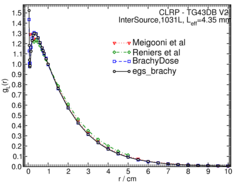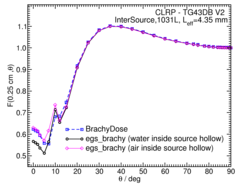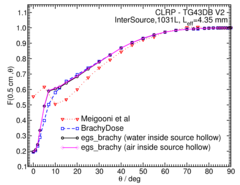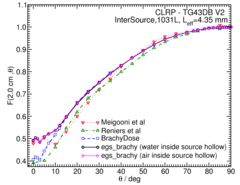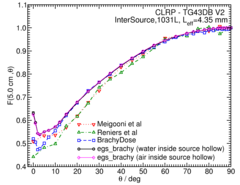
Source Description:
Dimensions for the InterSource seed 1 are taken from the study by Meigooni et al 1. The InterSource consists of two concentric hollow titanium cylindrical tubes which are laser welded together at the ends. The gas between the 2 tubes is assumed to be air. The total length of laser welded end cap is taken to be 0.2mm (Note: The previous database used a longer end cap). Each tube is 0.04 mm thick and the outer diameter of the inner and outer tubes is 0.5 mm and 0.81 mm, respectively. Reniers et al 2 study supposed the source outer diameter is 0.80 mm. There is a thin band (0.045 mm thick and 1.27 mm long) of 90% Pt and 10% Ir alloy deposited around the inner cylinder at its centre. The radioactive 103Pd is distributed uniformly throughout three cylindrical bands of an organic material (85.7% carbon 14.3% hydrogen with a density of 1.0 g/cm3, the 103Pd content is assumed to be negligible) deposited on the outside of the inner cylinder. The outer two bands of radioactive material are deposited on the inner cylinder and are 0.8 mm long, 0.015 mm thick and have their centers along the seed axis offset 1.45 mm from the middle of the seed. The center band is 0.5 mm long, 0.009 mm thick and centered on top of the Pt/Ir alloy while the center of the outer bands is offset from the middle by 1.6 mm. There is a negligible difference in the dose-rate constant (<0.05%), and radial dose function (<0.3%, r<0.08 cm) when considering either air or water as filling the inner hollow portion of the seed. However, the corresponding changes for anisotropy functions close to the source endcaps (0°<θ<10°, r=0.25 cm) generated a mean differences of 10%. For larger radial distances and polar angles, the mean differences were negligible (<0.2%). For DRC data (Table, xlsx) presented here, air occupied inside the source hollow, however, for radial dose and anisotropy functions the source hollow was filled with water. The overall length is 4.5 mm and the active length 3 of the seed is taken to be 4.35 mm. The mean photon energy calculated on the surface of the source in a water phantom is 20.47 keV with mean statistical uncertainties < 0.014%.
(Note: On average we observed deviations of up to 9% for the 2D anisotropy function at small angles near the source`s end caps (θ ≤ 10 °), since the previous database (CLRPv1) mistakenly modeled a longer laser welded end-cap geometry).
Dose-Rate Constant - Λ :
Dose-rate constants, Λ , are calculated by dividing the dose to water per history in a (0.1 mm)3 voxel centered on the reference position, (1 cm, Π/2), in the 30x30x30 cm3 water phantom, by the air-kerma strength per history (scored in vacuo). As described in ref. 4 , dose-rate constants are provided for air-kerma strength calculated using voxels of 2.66x2.66x0.05 cm3 (WAFAC) and 0.1x0.1x0.05 cm3 (point) located 10 cm from the source. The larger voxel size averages the air-kerma per history over a region covering roughly the same solid angle subtended by the primary collimator of the NIST WAFAC 5, 6 used for calibrating low-energy brachytherapy sources and is likely the most clinically relevant value. The small voxel serves to estimate the air-kerma per history at a point on the transverse axis and includes a small 1/r2 correction (0.5%) 4. egs_brachy and BrachyDose MC uncertainties are statistical uncertainties only (k=1). TLD values from ref. 1 and 2 are corrected to be in water despite being measured in SolidWater.
| Author | Method | Λ (cGy h-1 U-1) | Abs. Uncertainty |
| Safigholi et al 7 | WAFAC | 0.6625 | 0.0001 |
| Safigholi et al 7 | point | 0.6612 | 0.0015 |
| Taylor, Rogers 8 | WAFAC | 0.663 | 0.002 |
| Taylor, Rogers8 | point | 0.664 | 0.002 |
| Meigooni et al 1 | point (PTRAN) | 0.696 | 0.02 |
| Meigooni et al 1 | TLD | 0.700 | 0.044 |
| Reniers, et al 2 | TLD | 0.709 | 0.050 |
| Reniers, et al 2 | point (MCNP) | 0.692 | 0.01 |
| Rodriguez, Rogers 9 | TLD (Revised Meigooni) | 0.658 | 0.026 |
| Rivard et al 10 | TG-43U1S2 (Consensus Value) | 0.701 | 0.020 |
Radial dose function - g(r):
The radial dose function, g(r), is calculated using both line and point source geometry functions and tabulated at 36 different radial distances ranging from 0.05 cm to 10 cm. Fit parameters for a modified polynomial expression are also provided 11 . The mean residual deviations from the actual data for the best fit were < 0.19%.
| Fitting coefficients for g L (r) = (a0 r-2 + a1 r-1 + a2 + a3r + a4r2 + a5 r3) e-a6r | |||
| Fit range | Coefficients | ||
| r min (cm) | r max (cm) | ||
| 0.10 | 10.00 | a0 / cm2 | (2.61+/-0.09)E-03 |
| a1 / cm | (-1.068+/-0.011)E-01 | ||
| a2 | (1.867+/-0.004)E+00 | ||
| a3 / cm-1 | (6.0+/-0.8)E-02 | ||
| a4 / cm-2 | (-2.95+/-0.08)E-02 | ||
| a5 / cm-3 | (2.26+/-0.05)E-03 | ||
| a6 / cm-1 | (5.839+/-0.028)E-01 | ||
Anisotropy function - F(r,θ):
Anisotropy functions are calculated using the line source approximation and tabulated at radii of 0.1, 0.15, 0.25, 0.5, 0.75, 1, 2, 3, 4, 5, 7.5 and 10 cm and 32 unique polar angles with a minimum resolution of 5°. The anisotropy factor, φan (r), is calculated by integrating the solid angle weighted dose rate over 0° ≤ ϑ ≤ 90° .
Tabulated data:
References:
1. A. S. Meigooni et al , Dosimetric characteristics of the InterSource103 palladium brachytherapy source, Med. Phys. 27, (2000) 1093-1100.
2.B. Reniers et al, Dosimetric study of a new palladium seed, Applied Radiation and Isotopes, 57, 805–811, 2002. 3. M. Rivard et al, Response to “Comment on ‘Update of AAPM Task Group No. 43 Report: A revised AAPM protocol for brachytherapy dose calculations, Med. Phys. 32, 1822-1824, 2005.
4. R. E. P. Taylor et al , Benchmarking BrachyDose: voxel-based EGSnrc Monte Carlo calculations of TG-43 dosimetry parameters, Med. Phys., 34 , 445 - 457, 2007.
5. R. Loevinger, Wide-angle free-air chamber for calibration of low--energy brachytherapy sources, Med. Phys., 20 , 907, 1993.
6. S. M Seltzer et al , New National Air-Kerma-Strength Standards for 125I and 103Pd Brachytherapy Seeds, J. Res. Natl. Inst. Stand. Technol.,108,337 -358,2003. 7. H. Safigholi, M. J. P. Chamberland, R. E. P. Taylor, C. H. Allen, M. P. Martinov, D. W. O. Rogers, and R. M. Thomson, Updated of the CLRP TG-43 parameter database for low-energy photon-emitting brachytherapy sources, to be published (Current calculation).
8. R. E. P. Taylor, D. W. O. Rogers, An EGSnrc Monte Carlo-calculated database of TG-43 parameters, Med. Phys., 35 , 4228-4241, 2008.
9. M. Rodriguez and D. W. O. Rogers, Effect of improved TLD dosimetry on the determination of dose rate constants for 125I and 103Pd brachytherapy seeds, Med.Phys., 41, 114301, 2014. 10. M. Rivard et al, Supplement 2 for the 2004 update of the AAPM Task Group No. 43 Report: Joint recommendations by the AAPM and GECESTRO, Med. Phys., 44, 29733, 2017. 11. R. E. P. Taylor, D. W. O. Rogers, More accurate fitting of 125I and 103Pd radial dose functions, Med. Phys., 35 , 4242-4250, 2008.
